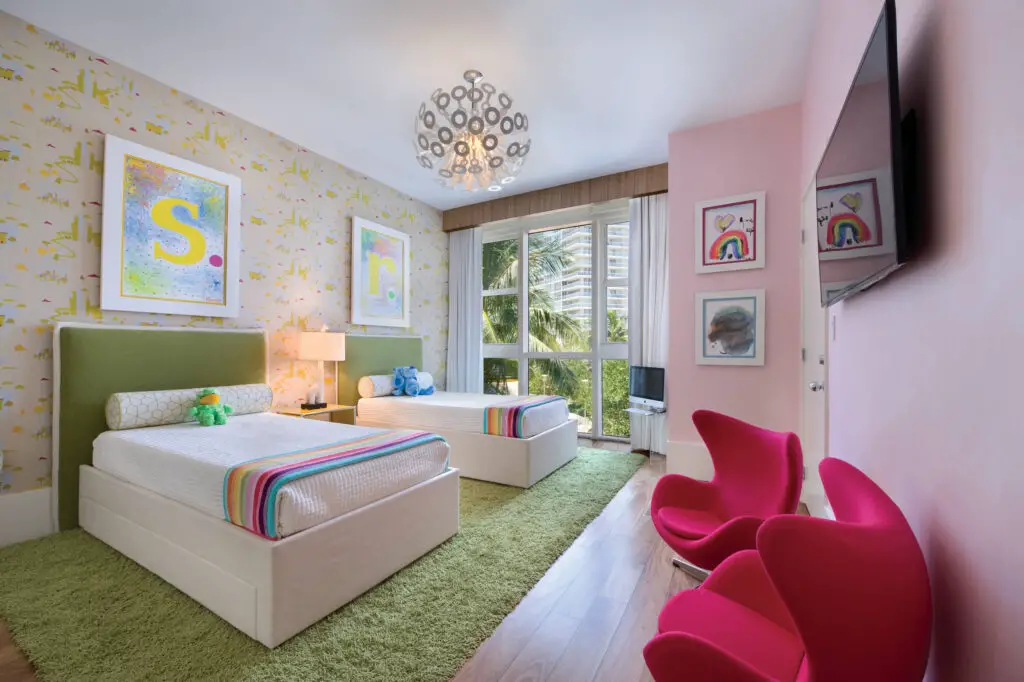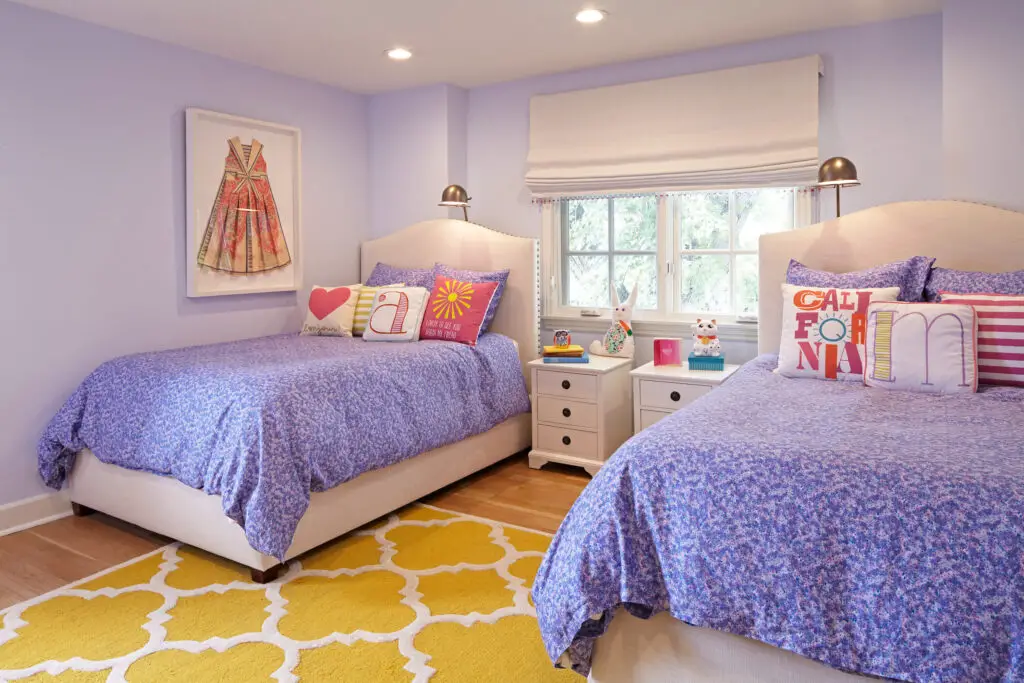
Introduction
Designing a shared kids’ room can be a delightful and challenging task. It requires creating a space that not only accommodates the needs and preferences of multiple children but also fosters a functional and fun environment. With the right ideas and a touch of creativity, you can transform a shared room into a harmonious haven for your little ones. In this article, we will explore some shared kids’ room ideas that strike the perfect balance between functionality and fun.
Shared Kids’ Room Ideas for a Functional and Fun Space
Designing a shared kids’ room involves considering various aspects such as space utilization, storage solutions, and creating distinct zones for each child’s personal space. Here are some fantastic ideas to help you create a functional and fun shared room for your children:
1. Bunk Beds: Maximizing Vertical Space
Bunk beds are a classic choice for shared kids’ rooms. They efficiently utilize vertical space, allowing each child to have their designated sleeping area while leaving ample floor space for play and other activities. Opt for sturdy and safe bunk beds with built-in storage compartments or shelves for additional functionality.
2. Colorful and Vibrant Decor: Adding Life to the Room
Incorporate bright and lively colors into the room’s decor to create a cheerful and energetic atmosphere. Use colorful bedding, curtains, and wall decals to infuse vibrancy into the space. Let each child choose their favorite colors, allowing them to personalize their side of the room.
3. Customized Storage Solutions: Organizing with Style
Efficient storage solutions are crucial in shared kids’ rooms to keep clutter at bay. Install custom-built shelving units, cubbies, or wall-mounted organizers to provide each child with their storage space. Labeling the storage compartments with their names or favorite symbols adds a touch of personalization.
4. Individual Workstations: Encouraging Creativity and Study
Designate separate workstations for each child, facilitating creativity and study. Provide individual desks or tables with comfortable seating, task lighting, and storage for school supplies and materials. Personalizing each workstation with unique accessories and artwork adds a personal touch.
5. Zoning with Room Dividers: Privacy and Personal Space
Create visual boundaries and a sense of privacy by using room dividers or curtains. This allows each child to have their defined area while still fostering a shared environment. Encourage children to decorate their side of the divider with posters, artwork, or photographs.
6. Themed Areas: Cultivating Imagination
Incorporate themed areas within the shared room to spark imagination and play. Create a cozy reading nook with a bookshelf and bean bags, a dress-up corner with a wardrobe and mirror, or a small indoor tent for imaginative adventures. Each themed area can reflect the unique interests of each child.
7. Collaborative Display Wall: Celebrating Individuality
Designate a wall where children can display their artwork, achievements, or photographs. This collaborative display wall not only showcases their individuality but also fosters a sense of pride and appreciation for each other’s accomplishments. Use corkboards, magnetic boards, or a combination of both for versatility.
8. Dual-Purpose Furniture: Maximizing Functionality
Opt for dual-purpose furniture to maximize functionality in a shared kids’ room. Consider loft beds with built-in study areas or trundle beds that can be tucked away during the day to create more play space. Foldable tables or chairs are also excellent options for multi-purpose use.
9. Sensible Room Layout: Flow and Accessibility
When arranging furniture and defining zones within the shared room, ensure a sensible layout that promotes flow and accessibility. Leave ample open space for movement and play. Avoid cluttering the room with excessive furniture or decor items, as it can hinder mobility and create a cramped environment.
10. Shared Storage Solutions: Encouraging Cooperation
Promote cooperation and a sense of shared responsibility by incorporating storage solutions that are accessible to both children. Use shared bookshelves, toy chests, or storage ottomans where they can keep their belongings together. This not only fosters a sense of teamwork but also teaches them valuable organizational skills.
11. Personalized Bedding: Expressing Individuality
Allow each child to express their unique style and personality through personalized bedding. Choose different patterns, colors, or themes for their beddings, pillows, and blankets. This not only adds a touch of individuality but also helps in identifying their respective sleeping areas.
12. Interactive Wall Art: Sparking Creativity
Transform the walls into interactive art displays to ignite your children’s creativity. Paint one wall with chalkboard paint, where they can freely draw and write. Install magnetic boards or panels where they can showcase their artwork using magnets. This interactive wall art encourages self-expression and imaginative play.
13. Flexible Seating Options: Adaptability and Comfort
Incorporate flexible seating options to accommodate various activities and preferences. Use bean bags, floor cushions, or modular seating that can be rearranged according to the children’s needs. This provides them with comfortable and adaptable seating for reading, playing games, or simply relaxing.
14. Sibling Collaboration Space: Fostering Bonding
Designate a collaborative space within the shared room, where children can engage in joint activities or projects. Set up a craft table with art supplies, a Lego-building corner, or a board game area. This dedicated space promotes sibling bonding, encourages teamwork, and enhances social skills.
15. Gender-Neutral Themes: Promoting Inclusivity
Opt for gender-neutral themes and decor choices to create an inclusive environment. Avoid stereotypical colors or motifs that may restrict one child’s self-expression or make them feel excluded. Instead, choose themes such as nature, space, or animals that appeal to both genders.
16. Bright Lighting: Enhancing the Ambiance
Ensure the room is well-lit with bright and adjustable lighting fixtures. Use ceiling lights, floor lamps, and desk lamps to provide adequate illumination for different activities. Dimmer switches or smart lighting systems can create various ambiance settings, suitable for playtime, study, or relaxation.
17. Noise Reduction Measures: Peaceful Coexistence
Shared rooms can sometimes become noisy, affecting each child’s sleep and concentration. Incorporate noise reduction measures such as carpets, rugs, or sound-absorbing panels to minimize sound transmission. This helps create a more peaceful coexistence within the shared space.
18. Inclusive Decorative Elements: Uniting the Room
Integrate decorative elements that unite the room and create a cohesive look. Use matching curtains, area rugs, or wall art that complement the overall theme or color scheme. This brings harmony to the shared space while still allowing each child’s individuality to shine through personal touches.
19. Engage Children in the Design Process: Empowering Ownership
Involve your children in the design process of their shared room. Seek their input, ideas, and preferences for color schemes, themes, or decor choices. Empowering them with a sense of ownership fosters their creativity, decision-making skills, and instills a deeper appreciation for their shared space.
20. Establish Ground Rules: Maintaining Harmony
Set clear ground rules and expectations for sharing the space. Teach children about respecting each other’s boundaries, cleaning up after themselves, and taking turns. Regularly remind them of these rules to maintain a harmonious and functional shared room environment.

Frequently Asked Questions (FAQs)
1. How do I handle conflicts between my children regarding shared room arrangements?
Answer: Conflict is natural in shared spaces. Encourage open communication and problem-solving skills. Teach them the importance of compromise and respecting each other’s preferences. If needed, involve them in finding mutually agreeable solutions.
2. What if there is a significant age or gender difference between my children?
Answer: Consider designing distinct areas within the room to cater to different age groups or interests. Use room dividers or color-coded zones to provide each child with their personal space while still maintaining a cohesive environment.
3. How can I ensure privacy for my children in a shared room?
Answer: Implement privacy measures such as curtains, room dividers, or designated quiet corners where children can retreat for personal time. Teach them to respect each other’s need for privacy and establish guidelines for privacy boundaries.
4. Are there any safety considerations for shared kids’ rooms?
Answer: Safety is crucial. Use sturdy furniture, secure bunk beds with safety rails, and anchor bookshelves to the wall. Ensure that electrical outlets are childproofed, cords are out of reach, and the room is free of potential hazards.
5. How can I make the room adaptable to changing needs as my children grow?
Answer: Opt for modular furniture and versatile storage solutions that can be easily reconfigured as your children’s needs evolve. Keep the decor flexible and allow them to update it over time to reflect their changing interests and personalities.
6. How can I encourage my children to keep the room tidy?
Answer: Teach them organizational skills and make tidying up a fun and interactive activity. Use labeled storage containers, colorful bins, and incentives for maintaining cleanliness. Encourage them to take pride in their shared space.
Conclusion
Designing a shared kids’ room that is both functional and fun requires careful planning and consideration. By implementing the shared kids’ room ideas mentioned in this article, you can create a space where your children feel comfortable, engaged, and inspired. Remember to involve them in the design process and establish clear guidelines to maintain harmony and encourage their individuality within the shared space. With a well-designed and thoughtfully organized room, your children can enjoy a functional and fun environment that fosters their growth, creativity, and sibling bond.


